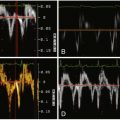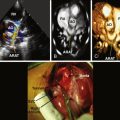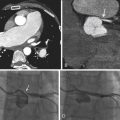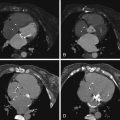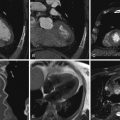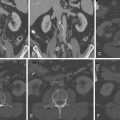Key Points
- ▪
Radiation exposure is an inherent and undeniable risk of cardiac CT.
- ▪
The favored unit to express radiation exposure per CT scan is the millisievert (mSv).
- ▪
Radiation risk relates linearly to exposure.
- ▪
Strategies to minimize radiation exposure should always be undertaken, and consideration should be given to alternatives that do not involve radiation (e.g., echocardiography or MRI).
- ▪
The risk of the scan must be weighed against the benefit of the procurable information, in the context of other means that may be available to garner the same information.
- ▪
Conversely, the risk of failing to identify or diagnose significant lesions must be considered in the context of concern about radiation-associated risk.
- ▪
Younger women represent the single highest risk group from cardiac CT scanning, because:
- ▪
Younger patients are more susceptible to malignancy.
- ▪
The radiation dose is higher in women because greater doses are needed to image the heart deep to breast-attenuating soft tissue.
- ▪
Breast cancer is a risk.
- ▪
The latent interval to develop malignancy is offset several-fold by expected years of life.
- ▪
- ▪
Radiation exposure inherent in cardiac CT scanning has fallen by more than a logarithm within the past 10 years, and submillisievert (<1 mSv) exposure is feasible with the newest generation of equipment.
Context and Perspective
Although the risk per single CT scan is small, given the enormous numbers of CT scans performed, this risk is neither small nor dismissible. Approximately 60 to 65 million CT scans of all types were performed in the United States in 2006 —one per five citizens. The rate is increasing at 10% to 25% per year. Approximately two thirds of a billion CT scans have been performed in the United States alone since 1980. It has been established that over the last several decades, the amount of radiation exposure per person per year has increased conspicuously (600% in 3 decades), due mainly to the proliferation of CT scanning. Medical imaging procedures, especially tomographic imaging and nuclear medicine, are important sources of exposure to ionizing radiation.
Thus, even if the risks of CT scanning are small per scan, given the sheer volume of scans, the risk does translate into events. It is estimated, although not yet proved, that approximately 0.4% of all cancer in the United States may be attributed to CT scanning. Radiation risk should be responsibly and knowledgeably addressed whenever cardiac CT (CCT), coronary computed tomographic angiography (CTA), electron beam CT (EBCT), or other type of CT scanning is being considered or when nuclear testing or any form of imaging that entails radiation exposure to patients is an option.
The actual risks of medical radiation are neither tabulated nor known; currently, they have been estimated only by models that understandably engender some controversy. The models are based on data from nuclear blasts over Hiroshima and Nagasaki, from the Chernobyl nuclear reactor leak, and from exposure of individuals engaged in nuclear testing for medical purposes, as well as from patients exposed to radiation. Unfortunately, more real data pertaining to emerged cancer risks in patients undergoing CT scanning for reasons other than cancer have never been gathered. It is a sobering fact that much medical diagnostic testing entails radiation exposure equivalent to what occurred at the periphery of Hiroshima and Nagasaki, whose populations, followed for half a century, did exhibit excessive rates of cancer.
Tubiana has understandably stated that overestimation of risk “may deprive patients of beneficial examinations.” Some of the controversy itself is controversial, such as objection to the linear no-threshold risk of radiation.
Few data have been tabulated to substantiate so many statements about CT scanning and the manner and the matter of its use. The net effect of CT scanning is simply the summation of the reduction of morbidity and mortality of lives by useful clinical diagnosis guiding successful therapy, and the incurred morbidity and mortality from radiation, contrast media, and other complications attributable to its use.
Radiation and Risk Overview
Biological Effects of Ionizing Radiation VII (2005)
The Biological Effects of Ionizing Radiation (BEIR) VII conference changed the paradigm of medical radiation risk modeling from a “threshold” to a “linear” risk model:
A comprehensive review of available and biophysical data supports a linear-no-threshold risk model—that the risk of cancer proceeds in a linear fashion at lower doses without a threshold and that the smallest dose has the potential to cause a small increase in risks to humans.
This landmark conference and its published proceedings are notable for advancing constructive discussion on radiation risk, which directed the discussion toward responsible management of the risk. This discussion then prompted enormous research and development and introduction of hardware and software upgrades and developments in CT scanner design and function that have brought about significant reductions in radiation exposure. The controversy regarding threshold versus linear risk simmers, based on radiotherapy data.
Organizations with Positions on the Linear No-Threshold Model
Organizations have taken a variety of positions on the linear no-threshold (LNT) model at <100 mSv :
- □
Basically supportive
- •
US National Research Council Biological Effects of Ionizing Radiation (BEIR) VII Phase 2 (2006)
- •
International Commission on Radiological Protection (2005)
- •
US National Council on Radiation Protection and Measurements (2001)
- •
United Nations Scientific Committee on the Effects of Atomic Radiation (2000)
- •
UK National Radiological Protection Board (1995)
- •
- □
LNT is oversimplication: risk estimates should not be used at <50 mSv:
- •
Health Physics Society (2004)
- •
- □
LNT overestimates risk:
- •
French Academy of Sciences/National Academy of Medicine (2004)
- •
American Nuclear Society (2001)
- •
Metrics of Radiation Dose
The subject of radiation dosage is highly complex; accordingly, radiation dosage can be expressed in a variety of metrics. The “effective dose” is widely quoted because it reflects biologic risk, although effective dose estimates do not apply to any individual patient. It is, however, far easier to determine the amount of emitted radiation than to determine the absorbed radiation, let alone the real biologic risk ( Table 3-1 ).
| Metric | Volume CT dose index (CTDI) | Dose-length product (DLP) (required in Europe) | Effective dose (E) |
| Unit | mGy | MGy ∗ cm | mSv |
| Description | Average volume within the scan volume | DLP = CTDI vol (mGy) × scan length (cm) | Represents biologic risk |
| Notes | A per-scan rotation metric Local dose (affected by kV, mAs) intensity Dose from the beam and its scatter | A per-exam metric Integrates the CTDI over the scan length (which is affected by pitch) Integral of intensity and coverage | A per-exam metric Intensity + coverage + sensitivity Dose effective = DLP × 0.017 |
In its Clinical Policy Statement for Noninvasive Cardiac Imaging, the American College of Radiology has recommended that cardiac imaging be restricted to no more than 13 mSv. The goal of medical diagnostic imaging is for radiation exposure to be as low as reasonably achievable and still be effective.
Units of Radiation
- □
1 Sv = 100 rem
- □
1 mSv = 0.1 rem = 100 mrem
- □
1 Sv = 1 Gr (“grey”), when dealing with photons
Factors Affecting Radiosensitivity
- □
Linear energy transfer (LET): the propensity of energy to transfer from ionizing radiation to tissue. X-rays have a small linear energy transfer.
- □
Relative biologic effectiveness (RBE): As the LET of radiation increases, the ability to produce biologic damage increases. This is quantitatively described as the RBE. The RBE of CT x-ray is 1. X-rays have a small biologic effectiveness.
- □
Age: Humans are most radiosensitive before birth and become progressively less sensitive with age. X-ray exposure should be assiduously avoided or—if absolutely essential— minimized during pregnancy.
Tube Voltage
Tube voltage is a major determinant of radiation exposure, and body size is the main determinant of voltage requirement. In most patients 100 to 120 kV tube voltage is sufficient for cardiac imaging. The radiation variation is the square of the variation of the tube voltage. Therefore, the occasional use of 140 kV to image very large patients prominently increases radiation exposure, and, conversely, reducing tube voltage to 100 or 80 kV in very small adults diminishes the radiation exposure by 30% to 50% while preserving contrast-to-noise ratio. Tube voltage should be reduced to 100 kV when body weight is less than 85 kg and BMI is less than 30 kg/m 2 ( Fig. 3-1 ).

Lifetime Adjusted Risk
The lifetime adjusted risk (LAR) of cancer attributable to prior CT scanning is debated, with estimates ranging from 1:2000 to 1:10,000. With an estimated latency of 12 years between exposure and development of cancer, the risk is lower in older populations and greater in younger populations.
Radiation Risk in Cardiac CT
It is easier to quantify the amount of exposed or absorbed radiation than to estimate the risk of the radiation. The attributed risk depends largely on the model used to project the risk, and all models have engendered some controversy. Most of the data on radiation risks are extrapolated from nuclear blast radiation exposure, and some originate from nuclear power generation station mishaps.
Animal data obtained in dogs suggest that there is a threshold of 200 mSv to the risk of radiation, but current recommendations (BEIR VII) articulate that there is no threshold and that risk is proportional to exposure.
In the following example of a model/calculation of risk for cardiac CT scanning, note all of the assumptions and that a range of numbers rather than a number is more appropriate ( Table 3-2 ).
| DEATH FROM | ODDS |
|---|---|
| Cardiovascular disease | 1:2.6 |
| Cancer | 1:4 |
| Car accident | 1:4,000 |
| Plane crash | 1:100,000 |
| Lightning | 1:2,320,000 |
Assume the following:
- □
10 mSv per CT scan
- □
CT after age 45 years, half of lifetime remaining
- □
Lifetime risk of cancer is relatively high: 1:1000 per 10 mSv over 70 years lifespan
- □
1 person in 4 dies of cancer each year
- □
cancer/(100 persons × 10 mSv × lifetime) × 1 death/cancer × lifetime/2 = 15 deaths/(100,000 person cardiac CT)
The highest single proportion of the total effective dose of radiation that patients are exposed to is from myocardial perfusion imaging (11%), although CT scanning cumulatively (CT abdomen, pelvis, chest, CT angiography, non-chest, CT head/brain, cervical spine, lumbar spine, neck) accounts for nearly half (45%). Diagnostic cardiac catheterization accounts for 5% and PCI for 2%. Chest radiography accounts for less than 1% (0.7%).
Radiation Dose from Cardiac CT Scanning and Lifetime Risks
Einstein et al. examined the radiation dose and lifetime risk of cancer from older 16-slice CTA and later from 64-slice CT scanners. The authors presented their estimation of radiation effective doses by different cardiac imaging modalities.
From 16-slice CT scanners, the average of the examined radiation dose was 9 mSv, increasing by 2.5 mSv to 11.5 mSv when calcium scoring was included. Women were exposed to more radiation than were men (13.5 mSv versus 11 mSv). The authors estimated the lifetime risk of cancer from 16-slice CT scanners to be 1:1600 (worst-case scenario: 1:500). The expected increase in cancers was in lung cancer and breast cancer. The radiation dose from 64-slice CT is estimated to be 50% higher.
In a different publication, Einstein et al. presented their calculation of lifetime attributable/adjusted risk (LAR) from 64-sclice CT scanners in an article cautioning against the overly aggressive use of coronary CT angiography. Their calculations of risk suggest that there is a non-negligible (as per BEIR VII) lifetime adjusted risk of malignancy associated with coronary and cardiac CT. This risk was age dependent because of (1) the latency of 12 or more years to development of radiation-induced malignancy and (2) the greater susceptibility to malignancy in younger patients. CT scanning of both the heart and aorta entailed greater radiation exposure and risk. The highest LARs were of lung cancer and of breast cancer in younger women. X-ray tube modulation significantly reduced calculated risk ( Fig. 3-2 ; Tables 3-3 through 3-5 ).

| EXPOSURE | AVERAGE RADIATION (mSv) | APPROXIMATE RANGE (mSv) | NOTES | |
|---|---|---|---|---|
| Radiation Exposures, by Way of Comparison | ||||
| Yearly background radiation | 3.6 | |||
| Exposure/hr in an airplane | 0.02 | |||
| Echocardiography | ||||
| Transthoracic | 0.0 | |||
| TEE | 0.0 | |||
| ICE | 0.0 | The fluoroscopy to deliver the wires entails some radiation. | ||
| Cardiac MRI | 0.0 | |||
| Chest Radiography | ||||
| Posteroanterior and lateral | 0.1 | [0.05–0.24] | Mainly from the lateral | |
| Posteroanterior | 0.01–0.02 | |||
| Lateral | 0.15 | |||
| Nuclear Cardiology | ||||
| MUGA scan | 5–8 | |||
| Sestamibi scan | 9 –13 | |||
| Thallium-201 scan | ||||
| Scan | 19 | |||
| Stress / rest | 41 | |||
| PET | ||||
| 18F FDG | 14 | |||
| Rubidium-82 | 5 | |||
| Coronary Angiography / PCI / Cardiac Fluoroscopy | ||||
| 4- to 6-fold variation in fluoroscopic radiation exposure in cardiac catheterization laboratories | ||||
| Coronary angiography | 7 5.6 ± 3.6 | [2–16] | ||
| PCI | 5–20 | [7–75] | ||
| Radiofrequency ablation | 15 | [7–75] | ||
| Computed Tomography | ||||
| Noncardiac | ||||
| Head | 1–2 | |||
| Cervical spine | 6 | |||
| Neck | 3 | |||
| Chest | 5–7 | [4–18] | ||
| Abdomen | 3–8 | [4–25] | ||
| Abdominal/pelvis | 8–11 | |||
| Lumbar spine | 6 | |||
| Pelvis | 3–6 | [3–10] | ||
| PE Protocol | ||||
| AAD protocol | 15 | |||
| AAA protocol | 12 | |||
| CT fluoroscopy | 74 mSv | CT fluoroscopy generates a radiation dose up to 20 times the dose of CT scanning. | ||
| Cardiac | ||||
| Calcium scoring | 0.8–3 | [1–12] | ||
| Coronary CTA | 10–15 | [2.5–40] | ||
| 16-CT | 14.7±2.2 | |||
| 6.4±1.9 | ||||
| 64-CT | Non-Dual Source | 11.0±4.1 | ||
| Without tube modulation | 15 | [12–18] | ||
| With tube modulation | 9 | [8–18] | ||
| Retrospective gating | 21.1±6.7 | |||
| Prospective triggering | 3 | [2–4] | ||
| 4.3±1.3 | ||||
| Dual Source | 7.8 | |||
| DS “step-and-shoot” | 2.5±0.8 | [1.2–4.4] | ||
| DS prospective gating 70% | 2.2±0.8 | |||
| DS tube modulation | 13 | [6–17] | ||
| 4.3±1.3 | ||||
| 1.2 | ||||
| 64-CT, 256-CT, 320-CT | ProspectiveTriggering / low kV / iterative reconstruction of raw data | <1 mSv | ||
Stay updated, free articles. Join our Telegram channel

Full access? Get Clinical Tree



